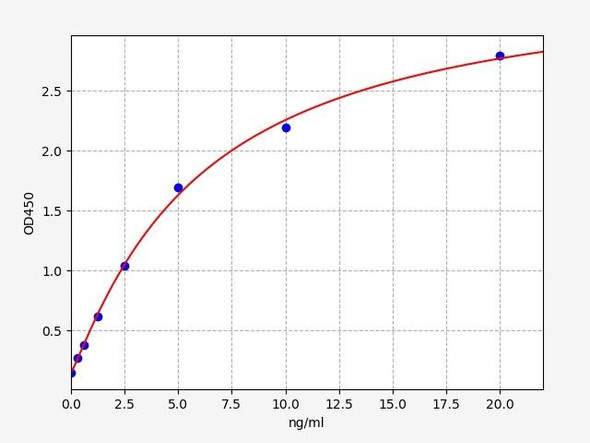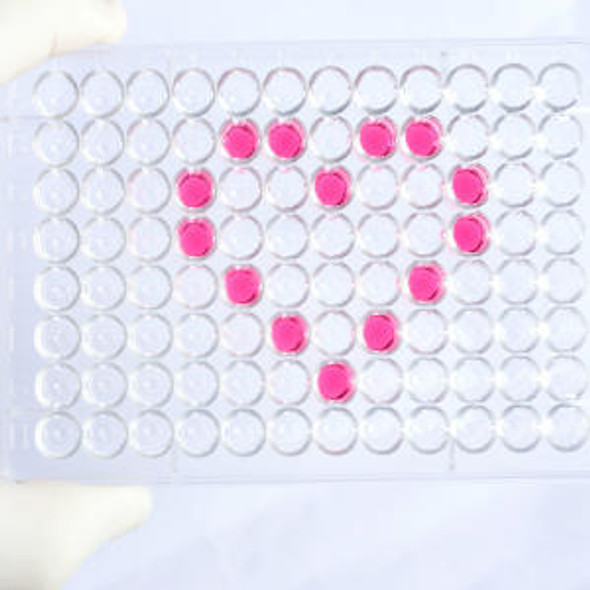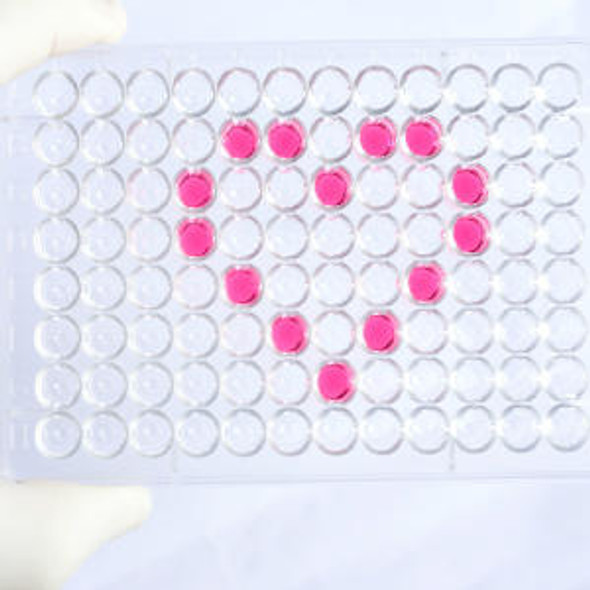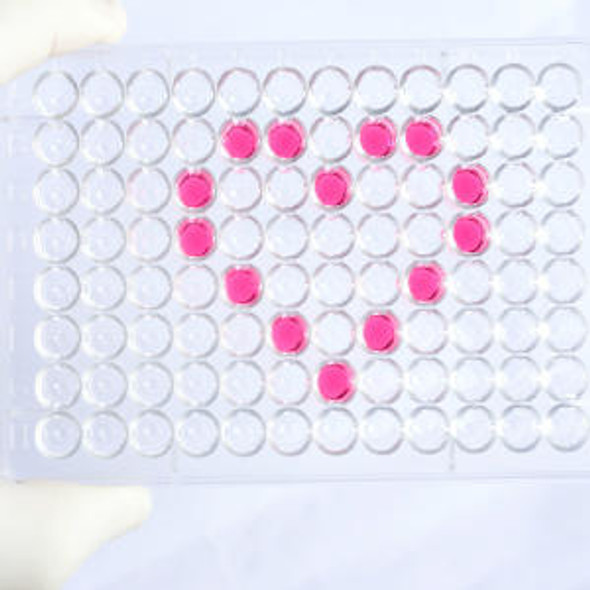Human NTRK2 (Neurotrophic Tyrosine Kinase Receptor Type 2 ) ELISA Kit (HUES02846)
- SKU:
- HUES02846
- Product Type:
- ELISA Kit
- Size:
- 96 Assays
- Uniprot:
- Q16620
- Sensitivity:
- 56.25pg/mL
- Range:
- 93.75-6000pg/mL
- ELISA Type:
- Sandwich
- Synonyms:
- TRKB, trk-B, GP145-TrkB, TrkB receptor, TrkB tyrosine kinase, BDNF/NT-3 growth factors receptor
- Reactivity:
- Human
- Sample Type:
- Serum, plasma and other biological fluids
- Research Area:
- Developmental Biology
Description
Human NTRK2 (Neurotrophic Tyrosine Kinase Receptor Type 2 ) ELISA Kit
The Human NTRK2 (Neurotrophic Tyrosine Kinase Receptor Type 2) ELISA Kit is expertly designed for the precise measurement of NTRK2 levels in human samples such as serum, plasma, and cell culture supernatants. With exceptional sensitivity and specificity, this kit delivers reliable and consistent results, making it an invaluable tool for various research endeavors.NTRK2, also known as TrkB, is a critical receptor involved in neurotrophic signaling pathways, playing a key role in neuronal survival, differentiation, and plasticity.
Dysregulation of NTRK2 has been implicated in various neurological disorders, including depression, Alzheimer's disease, and Parkinson's disease. Therefore, NTRK2 serves as a vital biomarker for understanding these conditions and devising potential therapeutic interventions.Overall, the Human NTRK2 ELISA Kit serves as a valuable resource for researchers seeking to unravel the complexities of neurotrophic signaling and its implications in neurological disorders.
| Assay type: | Sandwich |
| Format: | 96T |
| Assay time: | 4.5h |
| Reactivity: | Human |
| Detection Method: | Colormetric |
| Detection Range: | 93.75-6000 pg/mL |
| Sensitivity: | 56.25 pg/mL |
| Sample Volume Required Per Well: | 100µL |
| Sample Type: | Serum, plasma and other biological fluids |
| Specificity: | This kit recognizes Human NTRK2 in samples. No significant cross-reactivity or interference between Human NTRK2 and analogues was observed. |
This ELISA kit uses Sandwich-ELISA as the method. The micro ELISA plate provided in this kit has been pre-coated with an antibody specific to Human NTRK2. Standards or samples are added to the appropriate micro ELISA plate wells and combined with the specific antibody. Then a biotinylated detection antibody specific for Human NTRK2 and Avidin-Horseradish Peroxidase (HRP) conjugate are added to each micro plate well successively and incubated. Free components are washed away. The substrate solution is added to each well. Only those wells that contain Human NTRK2, biotinylated detection antibody and Avidin-HRP conjugate will appear blue in color. The enzyme-substrate reaction is terminated by adding Stop Solution and the color turns yellow. The optical density (OD) is measured spectrophotometrically at a wavelength of 450 nm ± 2 nm. The OD value is proportional to the concentration of Human NTRK2. The concentration of Human NTRK2 in samples can be calculated by comparing the OD of the samples to the standard curve.
| UniProt Protein Function: | TrkB: a receptor tyrosine kinase of the Trk family. Receptor for brain-derived neurotrophic factor (BDNF), neurotrophin-3, -4 and -5 but not nerve growth factor (NGF). Involved in the development and maintenance of the nervous system. Three splice variant isoforms have been described. |
| UniProt Protein Details: | Protein type:Membrane protein, integral; Kinase, protein; Protein kinase, TK; EC 2. 7. 10. 1; Protein kinase, tyrosine (receptor); TK group; Trk family Chromosomal Location of Human Ortholog: 9q22. 1 Cellular Component: cell surface; rough endoplasmic reticulum; integral to plasma membrane; dendritic spine; terminal button; excitatory synapse; perikaryon; cytosol; postsynaptic membrane; growth cone; presynaptic active zone; endosome membrane; receptor complex Molecular Function:brain-derived neurotrophic factor receptor activity; neurotrophin binding; protein homodimerization activity; ephrin receptor binding; brain-derived neurotrophic factor binding; ATP binding Biological Process: circadian rhythm; mechanoreceptor differentiation; peptidyl-tyrosine phosphorylation; retinal rod cell development; nerve growth factor receptor signaling pathway; protein amino acid autophosphorylation; neuron migration; regulation of dendrite development; regulation of neurotransmitter secretion; positive regulation of synaptic transmission, glutamatergic; neuron differentiation; positive regulation of MAPKKK cascade; positive regulation of cell proliferation; oligodendrocyte differentiation; feeding behavior; negative regulation of neuron apoptosis; inflammatory response; vasculogenesis; neuromuscular junction development; central nervous system neuron development; aging; response to light stimulus; brain-derived neurotrophic factor receptor signaling pathway; adenylate cyclase activation; regulation of protein kinase B signaling cascade; learning; positive regulation of peptidyl-serine phosphorylation; positive regulation of phosphoinositide 3-kinase cascade; peripheral nervous system neuron development; long-term memory; glutamate secretion; positive regulation of axonogenesis; cerebral cortex development; transmembrane receptor protein tyrosine kinase signaling pathway Disease: Obesity, Hyperphagia, And Developmental Delay |
| NCBI Summary: | This gene encodes a member of the neurotrophic tyrosine receptor kinase (NTRK) family. This kinase is a membrane-bound receptor that, upon neurotrophin binding, phosphorylates itself and members of the MAPK pathway. Signalling through this kinase leads to cell differentiation. Mutations in this gene have been associated with obesity and mood disorders. Alternative splicing results in multiple transcript variants. [provided by RefSeq, May 2014] |
| UniProt Code: | Q16620 |
| NCBI GenInfo Identifier: | 2497560 |
| NCBI Gene ID: | 4915 |
| NCBI Accession: | Q16620. 1 |
| UniProt Secondary Accession: | Q16620,Q16675, Q59GJ1, Q8WXJ5, Q8WXJ6, Q8WXJ7, B1ANZ4 B4DFV9, |
| UniProt Related Accession: | Q16620 |
| Molecular Weight: | 822 |
| NCBI Full Name: | BDNF/NT-3 growth factors receptor |
| NCBI Synonym Full Names: | neurotrophic tyrosine kinase, receptor, type 2 |
| NCBI Official Symbol: | NTRK2 |
| NCBI Official Synonym Symbols: | TRKB; trk-B; GP145-TrkB |
| NCBI Protein Information: | BDNF/NT-3 growth factors receptor; tyrosine kinase receptor B; tropomyosin-related kinase B; BDNF-tropomyosine receptor kinase B |
| UniProt Protein Name: | BDNF/NT-3 growth factors receptor |
| UniProt Synonym Protein Names: | GP145-TrkB; Trk-B; Neurotrophic tyrosine kinase receptor type 2; TrkB tyrosine kinase; Tropomyosin-related kinase B |
| Protein Family: | BDNF/NT-3 growth factors receptor |
| UniProt Gene Name: | NTRK2 |
| UniProt Entry Name: | NTRK2_HUMAN |
As the OD values of the standard curve may vary according to the conditions of the actual assay performance (e. g. operator, pipetting technique, washing technique or temperature effects), the operator should establish a standard curve for each test. Typical standard curve and data is provided below for reference only.
| Concentration (pg/mL) | O.D | Average | Corrected |
| 6000 | 2.482 2.496 | 2.489 | 2.414 |
| 3000 | 1.606 1.638 | 1.622 | 1.547 |
| 1500 | 0.986 0.954 | 0.97 | 0.895 |
| 750 | 0.496 0.514 | 0.505 | 0.43 |
| 375 | 0.29 0.266 | 0.278 | 0.203 |
| 187.5 | 0.178 0.178 | 0.178 | 0.103 |
| 93.75 | 0.125 0.131 | 0.128 | 0.053 |
| 0 | 0.069 0.081 | 0.075 | -- |
Precision
Intra-assay Precision (Precision within an assay): 3 samples with low, mid range and high level Human NTRK2 were tested 20 times on one plate, respectively.
Inter-assay Precision (Precision between assays): 3 samples with low, mid range and high level Human NTRK2 were tested on 3 different plates, 20 replicates in each plate.
| Intra-assay Precision | Inter-assay Precision | |||||
| Sample | 1 | 2 | 3 | 1 | 2 | 3 |
| n | 20 | 20 | 20 | 20 | 20 | 20 |
| Mean (pg/mL) | 296.44 | 588.37 | 2686.82 | 283.59 | 549.76 | 2437.26 |
| Standard deviation | 19.74 | 24.48 | 84.10 | 17.84 | 31.39 | 97.73 |
| C V (%) | 6.66 | 4.16 | 3.13 | 6.29 | 5.71 | 4.01 |
Recovery
The recovery of Human NTRK2 spiked at three different levels in samples throughout the range of the assay was evaluated in various matrices.
| Sample Type | Range (%) | Average Recovery (%) |
| Serum (n=5) | 92-109 | 100 |
| EDTA plasma (n=5) | 83-98 | 90 |
| Cell culture media (n=5) | 90-104 | 97 |
Linearity
Samples were spiked with high concentrations of Human NTRK2 and diluted with Reference Standard & Sample Diluent to produce samples with values within the range of the assay.
| Serum (n=5) | EDTA plasma (n=5) | Cell culture media (n=5) | ||
| 1:2 | Range (%) | 95-110 | 95-106 | 92-106 |
| Average (%) | 100 | 101 | 98 | |
| 1:4 | Range (%) | 92-107 | 79-90 | 87-101 |
| Average (%) | 99 | 85 | 93 | |
| 1:8 | Range (%) | 90-103 | 84-96 | 81-95 |
| Average (%) | 95 | 89 | 87 | |
| 1:16 | Range (%) | 90-105 | 79-93 | 86-100 |
| Average (%) | 96 | 85 | 92 |
An unopened kit can be stored at 4°C for 1 month. If the kit is not used within 1 month, store the items separately according to the following conditions once the kit is received.
| Item | Specifications | Storage |
| Micro ELISA Plate(Dismountable) | 8 wells ×12 strips | -20°C, 6 months |
| Reference Standard | 2 vials | |
| Concentrated Biotinylated Detection Ab (100×) | 1 vial, 120 µL | |
| Concentrated HRP Conjugate (100×) | 1 vial, 120 µL | -20°C(shading light), 6 months |
| Reference Standard & Sample Diluent | 1 vial, 20 mL | 4°C, 6 months |
| Biotinylated Detection Ab Diluent | 1 vial, 14 mL | |
| HRP Conjugate Diluent | 1 vial, 14 mL | |
| Concentrated Wash Buffer (25×) | 1 vial, 30 mL | |
| Substrate Reagent | 1 vial, 10 mL | 4°C(shading light) |
| Stop Solution | 1 vial, 10 mL | 4°C |
| Plate Sealer | 5 pieces | |
| Product Description | 1 copy | |
| Certificate of Analysis | 1 copy |
- Set standard, test sample and control (zero) wells on the pre-coated plate and record theirpositions. It is recommended to measure each standard and sample in duplicate. Note: addall solutions to the bottom of the plate wells while avoiding contact with the well walls. Ensuresolutions do not foam when adding to the wells.
- Aliquot 100µl of standard solutions into the standard wells.
- Add 100µl of Sample / Standard dilution buffer into the control (zero) well.
- Add 100µl of properly diluted sample (serum, plasma, tissue homogenates and otherbiological fluids) into test sample wells.
- Cover the plate with the sealer provided in the kit and incubate for 90 min at 37°C.
- Aspirate the liquid from each well, do not wash. Immediately add 100µL of BiotinylatedDetection Ab working solution to each well. Cover the plate with a plate seal and gently mix. Incubate for 1 hour at 37°C.
- Aspirate or decant the solution from the plate and add 350µL of wash buffer to each welland incubate for 1-2 minutes at room temperature. Aspirate the solution from each well andclap the plate on absorbent filter paper to dry. Repeat this process 3 times. Note: a microplatewasher can be used in this step and other wash steps.
- Add 100µL of HRP Conjugate working solution to each well. Cover with a plate seal andincubate for 30 min at 37°C.
- Aspirate or decant the solution from each well. Repeat the wash process for five times asconducted in step 7.
- Add 90µL of Substrate Reagent to each well. Cover with a new plate seal and incubate forapproximately 15 min at 37°C. Protect the plate from light. Note: the reaction time can beshortened or extended according to the actual color change, but not by more than 30min.
- Add 50 µL of Stop Solution to each well. Note: Adding the stop solution should be done inthe same order as the substrate solution.
- Determine the optical density (OD value) of each well immediately with a microplate readerset at 450 nm.






